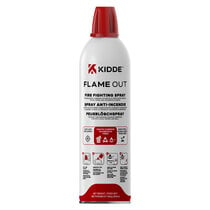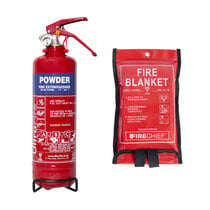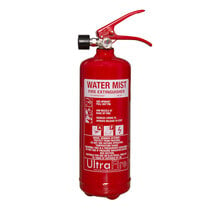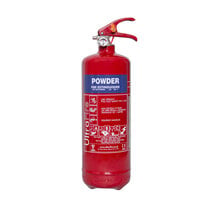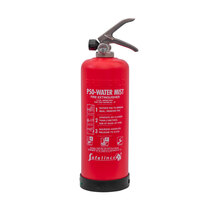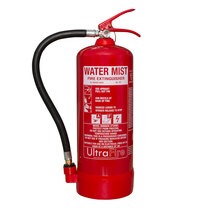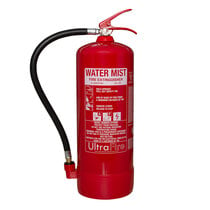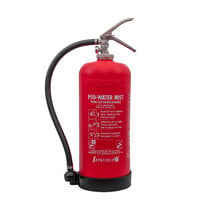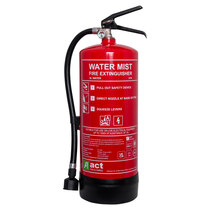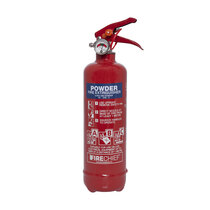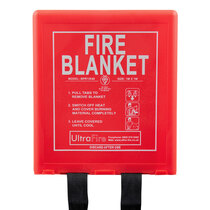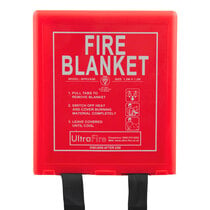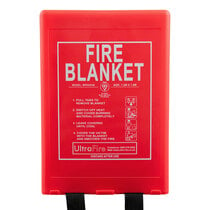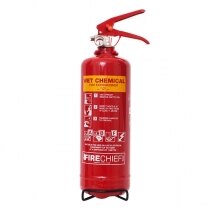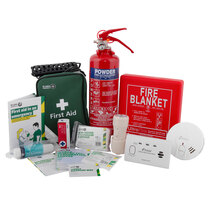-
Contact
Sales & Customer Service
0800 612 6537 support@safelincs.co.uk Live ChatDelivery Enquiries
0800 077 6149 - Resources
Fire & Safety Solutions
CALL OUR TEAM NOW 0800 612 6537
Lines open today 8am - 6pm
FREE Delivery
on marked products
Live Chat - Online
Instant help & Advice
Trade Discounts
and exclusive pricing
0% Credit Available
Open an account now
5 Star Customer Feedback
Domestic Fire Extinguishers
When fire breaks out in your home, every second counts. A fire extinguisher can be the difference between a minor incident and a devastating blaze that destroys everything you hold dear. But choosing the right one for your home isn't as simple as grabbing the first red cylinder you see. Types of fire extinguishers for your home Most homes require a multi-purpose fire extinguisher that can effectively tackle various types of fires. The best choice for domestic use is typically a water mist fire extinguisher, as these can effectively handle the most common household fires, including those caused by burning wood, paper, textiles, and cooking oils. Powder extinguishers are useful for garages and workshops as they will effectively tackle fires involving flammable liquids like petrol or paint, as well as wood and paper. They are not ideal for use in the house as they create a lot of mess when dispersed. For kitchens specifically, a water mist fire extinguisher should be sufficient unless you have a large quantity deep fat fryer. If this is the case, it is advisable to have a wet chemical fire extinguisher to hand. These are specially designed to cool burning oil and create a barrier that prevents re-ignition. A fire blanket is an additional tool that is useful to have on hand in a kitchen environment in the event of a fire. Placing fire extinguishers in your home The kitchen is your priority. This is where most house fires start, so keep a fire extinguisher within easy reach of your cooking area – but not so close that you'd have to reach over flames to grab it. Consider placing fire extinguishers on each floor of your home, particularly near high-risk areas such as the garage, workshop, or fireplace. Mount them on walls where everyone can see and easily reach them. Don't hide them in cupboards or behind doors. How big should a home fire extinguisher be? For most homes, a 2kg or 3kg fire extinguisher strikes the right balance between effectiveness and manageability. These are light enough for most people to handle but contain enough suppressant to deal with small to medium fires. Larger 6kg models pack more punch but can be heavy and awkward in an emergency. Smaller 1kg extinguishers are easier to handle and are ideal for extinguishing small fires as soon as they start. Different fire extinguishers may be required for different rooms Different rooms present different fire risks, so your choice of fire extinguisher should match the specific hazards likely to occur in each room. Your kitchen needs something that can handle oil fires, your living room might need protection against electrical fires from entertainment systems, and your garage or workshop may need coverage for flammable liquids. A good approach is to choose versatile extinguishers that can handle multiple fire types, then add specialist ones for specific high-risk areas. This provides comprehensive protection without cluttering your home with unnecessary equipment. Checking your fire extinguisher regularly Check your fire extinguisher monthly. Look at the pressure gauge – the needle should be in the green zone. Examine the body for dents, rust, or damage. Ensure the safety pin is intact and the operating instructions are readable. In a commercial setting, professional servicing should happen annually (this is not required in a domestic environment). This involves checking the internal components, testing the pressure, and replacing any worn parts as needed. Many manufacturers recommend replacing extinguishers every 5 to 10 years, depending on the type of extinguisher. The difference between powder and foam fire extinguishers Powder extinguishers are the most versatile for home use. They work on most types of fires, including electrical fires, making them a versatile and reliable choice. However, they create a lot of residue that can damage electronics and make cleanup difficult. Foam extinguishers are good all-rounders for tackling ordinary combustibles and flammable liquids, and usually fires involving electrical equipment. However, water mist is a better option. Vehicle-specific fire extinguishers Car fire extinguishers are designed to address the unique challenges of vehicle fires and are compact. They typically use powder or foam and are compact enough to fit in a glove compartment or under a seat. Vehicle fires can involve fuel, oil, electrical systems, and interior materials, so you need an extinguisher that can handle multiple types of fires. Powder fire extinguishers are a popular choice for vehicles as they cover all common fire types found in or around vehicles. Protecting your home and family starts with being prepared. Explore our selection of domestic fire extinguishers and discover the ideal protection for your specific needs. Understanding the different fire extinguisher types available helps you make informed choices for your home's safety requirements. For kitchen safety specifically, our guide on pan fires and fire extinguishers provides essential information about tackling cooking oil fires safely. Our expert team can help you choose the perfect fire safety solution for your home, because when it comes to fire safety, there's no room for compromise. Frequently Asked Questions (FAQs) Can I use a fire extinguisher if I haven't received training? Yes, but only if you're confident and the fire is small. Fire extinguishers use the PASS technique: Pull the pin, Aim at the base of the fire, Squeeze the handle, and Sweep from side to side. However, if you're unsure about whether it's safe to use a fire extinguisher, alert others, leave the building and call 999. Should I teach my children how to use a fire extinguisher? It is not recommended to teach children to use fire extinguishers; instead, they should focus on getting to safety. Fire extinguishers are heavy, making the situation potentially dangerous for young people to handle and it may delay them evacuating to safety in time. What happens if I drop my fire extinguisher? Since fire extinguishers are pressurised, dropping one may damage the functionality. Check the pressure gauge afterwards - if it's not in the green zone, it may be time to replace it. Are there any fires that I should never attempt to tackle myself? Never attempt to fight large fires, fires that are spreading rapidly, or any fire if you don't have a clear escape route. Only use a fire extinguisher when the fire is small and contained, everyone else is out of the building, and you're physically able to operate it. What if my fire extinguisher pressure gauge is in the red zone? If the pressure indicator is in either red zone, the fire extinguisher needs servicing or replacing immediately and shouldn't be used. The green zone indicates proper pressure for effective operation.
Read more about domestic fire extinguishers...
500ml Compact Home Fire Extinguisher / Fire Fighting Spray - Kidde Flame Out
A compact solution for your home fire fighting needs. Suitable for your home and effective for most common types of fires.
- Extinguishes grease, wood, paper, and household waste
- Safe and environmentally friendly
- Lightweight and easy to use aerosol design
- 2 year warranty
1ltr+ Water Mist Fire Extinguisher & Fire Blanket Special Offer
This 1ltr water mist fire extinguisher and 1.0m x 1.0m fire blanket special offer is ideal for small kitchens.
- FREE delivery
- Residue-free agent
- For Class A, B, C, F fires and live electrical equipment
- Complete with 1.0m x 1.0m fire blanket
1kg Powder Fire Extinguisher & Fire Blanket Special Offer
This 1kg powder fire extinguisher and compact 1.0m x 1.0m fire blanket offer is ideal for domestic garages and workshops.
- FREE delivery
- Powder Extinguisher Rating: 5A, 34B, C
- Complete with 1.0m x 1.0m fire blanket
- Ideal for home garages or workshops
1ltr+ Water Mist Fire Extinguisher - UltraFire
The best solution for home owners & owners of holiday cottages or caravans. These extinguisher are safe to use & effective for most common types of fires.
- Proven on class A, B, C, and F fires
- Safe on electrical equipment
- 100% non-harmful and 100% clean agent
- Perfect for clothing fires
2kg Powder Fire Extinguisher - UltraFire
A handy all-rounder, these small powder units are great for commercial vehicles and small outdoor fire risks.
- Extinguisher Rating: 13A, 70B, C
- 5 Year Warranty
- Kitemarked to BS EN3: 1996
- CE marked
6ltr Water Fire Extinguisher - UltraFire
This 6 litre water fire extinguisher is ideal for fighting class A fires without using any other chemicals.
- Extinguisher rating: 13A
- 35,000 Volt dielectric conductvity test: PASSED
- 5 year warranty
- CE marked, Kitemarked to BS EN3
P50 Service-Free 2ltr Water Mist Fire Extinguisher
Capable of tackling all common fires, these extinguishers are suitable for all domestic premises and most businesses.
- Extinguisher Rating: 8A, 5F
- Kitemarked by BSI to BS EN3
- Safe for use on live electrical equipment up to 1000V
- Manufactured in the UK
- Optional install and commissioning
3ltr Water Mist Fire Extinguisher - UltraFire
Utilising the latest in water mist technology, the 3l water mist is suitable for private homes as well as business environments.
- Effective on A, B, C, and F type fires
- Safe on live electrical equipment up to 1000V
- 100% non-harmful and 100% clean agent
- Kitemarked and CE marked
6ltr Water Mist Fire Extinguisher - UltraFire
An innovation in fire fighting equipment, this water mist extinguisher fights a multitude of fires whilst maintaining the user's safety using microscopic water mist particles.
- Effective on A, B, and C type fires
- Safe on live electrical equipment up to 1000V
- 100% non-harmful and 100% clean agent
- Kitemarked and CE marked
P50 Service-Free 6ltr Water Mist Fire Extinguisher
Replace your standard water and CO2 combination fire points with a single unit, suitable for all common fires.
- Extinguisher Rating: 13A
- Safe for use on live electrical equipment up to 1000V
- Kitemarked by BSI to BS EN3
- Manufactured in the UK
- Price includes site survey, install and commissioning
6ltr Water Mist Fire Extinguisher - Act Fire
Tackle all common fires with the 6ltr water mist extinguisher from Act Fire. Suitable for use on live electrical equipment up to 1000V, and Class A fire types.
- Extinguisher Rating: 21A, Dielectric
- Warranty: Exclusive Safelincs 5 year warranty
- Certified to BS EN3, CE marked, UKCA marked, and MED approved
- Powerful fire fighting capabilities with zero harmful chemical additives
0.6kg & 0.8kg Powder Fire Extinguishers for Cars, Caravans and Travel - Firechief
These lightweight and compact powder extinguishers from Firechief, available in 600g & 800g versions, have impressive fire fighting capabilities and are ideal for cars, caravans and travel.
- ABC powder fire extinguisher available in two sizes: 600g and 800g
- Extinguisher Rating: 600g: 5A, 21B, C & 800g: 5A, 34B, C
- 5 year warranty
- CE marked and LPCB approved to BS EN3 (excl. clause 6.1 - size requirement)
600g & 950g Powder Fire Extinguishers for Cars and Caravans - UltraFire
Ideal for cars, caravans and travel applications, the UltraFire Alpha (600g) and UltraFire Beta (950g) powder fire extinguishers feature a 5 year warranty.
- Dry powder fire extinguisher available in two sizes: 600g and 950g
- Extinguisher Rating: 600g: 13B, C & 950g: 21B, C
- 5 Year Warranty
- CE Marked and Kitemarked
Economy Fire Blanket
- Contained in soft pouch
- Reinforced eyelet for ease of hanging
- 5 year cloth warranty
- Kitemarked to BS EN 1869:2019
UltraFire Fire Blanket 1.0 x 1.0m
- High quality fire blanket
- Durable wall mounted case
- 5 year cloth warranty
- Certified to BS EN 1869:2019
UltraFire Fire Blanket 1.2 x 1.2m
- High quality fire blanket
- Durable wall mounted case
- 5 year cloth warranty
- Certified to BS EN 1869:2019
UltraFire Fire Blanket 1.2 x 1.8m
- High quality fire blanket
- Durable wall mounted case
- 5 year cloth warranty
- Certified to BS EN 1869:2019
2ltr Wet Chemical Fire Extinguisher
This small but mighty extinguisher is perfect for small commercial kitchens, burger vans, food stalls and home use. Suitable for use on cooking oil.
- Extinguisher Ratings 8A, 34B, 25F
- CE marked and BS EN3 approved
- Supplied with transport wall bracket
- Ideal for small kitchens, holiday homes, canteens, etc.
Home Working Fire Safety Kit - Safelincs
- Fire blanket included for emergency escape
- Supplied with a portable powder extinguisher and emergency light
- St John Ambulance first aid kit provides the essentials for minor injuries
- Also supplied with an optical smoke alarm and CO alarm
- Protect your home office / home working environment
What type of fire extinguisher is best for a home?
What type of fire extinguisher is best for a home?
Previously, powder extinguishers were recommended as ‘all purpose’ units which could be used for a wide range of applications. More current guidelines advise against using them indoors. Once a powder extinguisher is discharged, a dense cloud of fine powder is produced which can result in blocking vision and cause breathing difficulties, this is intensified within a confined space. Powder is also known to slowly erode environments if not cleared properly, which would be challenging due to the many crevasses found in many households.
Water mist extinguishers are recommended as versatile, multi-purpose fire extinguishers, suitable for use on most types of fires. They are environmentally friendly, containing no harmful chemicals, and leave no residue when discharged. Filled with de-ionized water, these extinguishers have undergone dielectric testing, making them safe for use on live electrical equipment, as well as being effective for cooking oil and fat fires.
Please Note: Whilst this extinguisher has been certified for Class F fires (like others on the market), following our own independent research we do not recommend using water mist on anything above a 5F rated fire (this is equivalent to an average domestic deep fat fryer). For fires above a 5F rating we recommend a wet chemical extinguisher.
Fire Blankets
Fire blankets, made from heat-resistant materials like fiberglass, are an effective and simple emergency tool that should be replaced after use. They are essential for tackling small fires, particularly in the kitchen and on clothing. Ideal for cooking fires, such as grease fires (Class F), they smother flames without causing splashes. Additionally, they can be wrapped around a person to extinguish clothing fires safely.
We have a help guide with further information on fire extinguishers for domestic use. Within this guide you can find advise on individual areas within households.




















